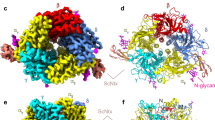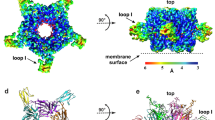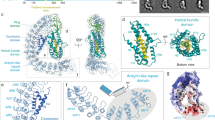Abstract
USE of purified snake venom neurotoxins with potent curarimimetic action on peripheral cholinergic transmission (for example, α-bungarotoxin1) in the study of the biochemical properties of the nicotinic cholinoceptor has met with considerable success (see ref. 2 for review). Some of the crude venoms from which such toxins have been isolated also contain toxins which act presynaptically, such as β-bungarotoxin1, notexin3 and taipoxin4. These three toxins inhibit the release of acetylcholine by a mechanism which is independent of the release process per se3–7. We show here that in an in vitro membrane preparation8 derived from the cholinergic endings in Torpedo electric organ these and related toxins are potent inhibitors of the high-affinity choline transport system. These observations provide a biochemical explanation for the inhibitory action of these toxins on transmitter release as they effectively block re-synthesis of acetylcholine from choline.
This is a preview of subscription content, access via your institution
Access options
Subscribe to this journal
Receive 51 print issues and online access
$199.00 per year
only $3.90 per issue
Buy this article
- Purchase on Springer Link
- Instant access to full article PDF
Prices may be subject to local taxes which are calculated during checkout
Similar content being viewed by others
References
Chang, C. C. & Lee, C. Y. Archs Int.Pharmacodyn. 144, 241–257 (1963).
Rang, H. P. Q. Rev. Biophys. 7, 283–399 (1975).
Harris, J. B., Karlsson, E. & Thesleff, S. Br. J. Pharmac. 47, 141–146 (1973).
Kamenskaya, M. A. & Thesleff, S. Acta. physiol. Scand. 90, 716–724 (1974).
Lee, C. Y. & Chang, C. C. Mem. Inst. Butanton. 33, 555–572 (1966).
Cull-Candy, S. G. et al. Neuroscience 1, 175–180 (1976).
Fohlman, J., Eaker, D., Karlsson, E. & Thesleff, S. Eur. J. Biochem. 68, 457–469 (1976).
Dowdall, M. J., Fox, G. F., Wächtler, K., Whittaker, V. P. & Zimmermann, H. Cold Spring Harb. Symp. quant. Biol. 40, 65–81 (1976).
Dowdall, M. J. & Zimmermann, H. Neuroscience 2, 405–421 (1977).
Dowdall, M. J., Barrantes, F. J., Stender, W. & Jovin, T. M. J. Neurochem. 27, 1253–1255 (1976).
Halpert, J., & Eaker, D. J. biol. Chem. 250, 6990–6997 (1975).
Halpert, J. & Eaker, D. J. biol. Chem. 251, 7343–7347 (1976).
Fohlman, J. & Eaker, D. Toxicon 15, 385–393 (1977).
Dowdall, M. J. in The Biochemistry of Characterized Neurons (ed. Osborne, N. N.) 177–216 (Pergamon, Oxford, 1977).
Sen, I., Grantham, P. A. & Cooper, J. R. Proc. natn. Acad. Sci. U.S.A. 73, 2664–2668 (1976).
Kelly, R. B., Oberg, S. G., Strong, P. N. & Wagner, G. M. Cold Spring Harb. Symp. quant. Biol. 40, 117–125 (1976).
Kelly, R. B. & Brown, F. R. J. Neurobiol. 5, 135–150 (1974).
Karlsson, E., Arnberg, H. & Eaker, D. Eur. J. Biochem. 21, 1–16 (1971).
Author information
Authors and Affiliations
Rights and permissions
About this article
Cite this article
DOWDALL, M., FOHLMAN, J. & EAKER, D. Inhibition of high-affinity choline transport in peripheral cholinergic endings by presynaptic snake venom neurotoxins. Nature 269, 700–702 (1977). https://doi.org/10.1038/269700a0
Received:
Accepted:
Issue Date:
DOI: https://doi.org/10.1038/269700a0
This article is cited by
-
The influence of taipoxin on cholinergic synapses in the electric organ ofTorpedo Marmorata
Journal of Neural Transmission (1978)
Comments
By submitting a comment you agree to abide by our Terms and Community Guidelines. If you find something abusive or that does not comply with our terms or guidelines please flag it as inappropriate.



